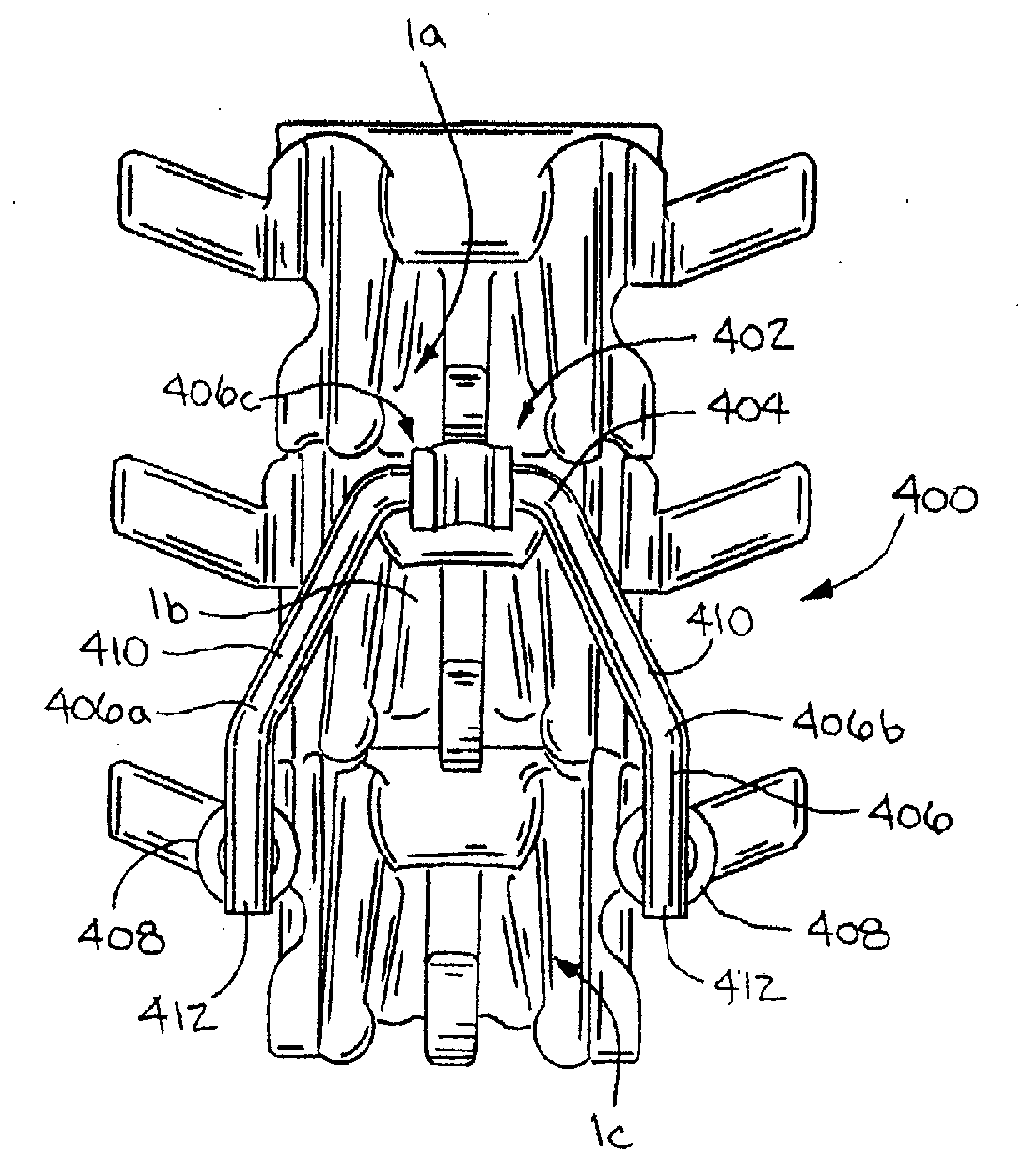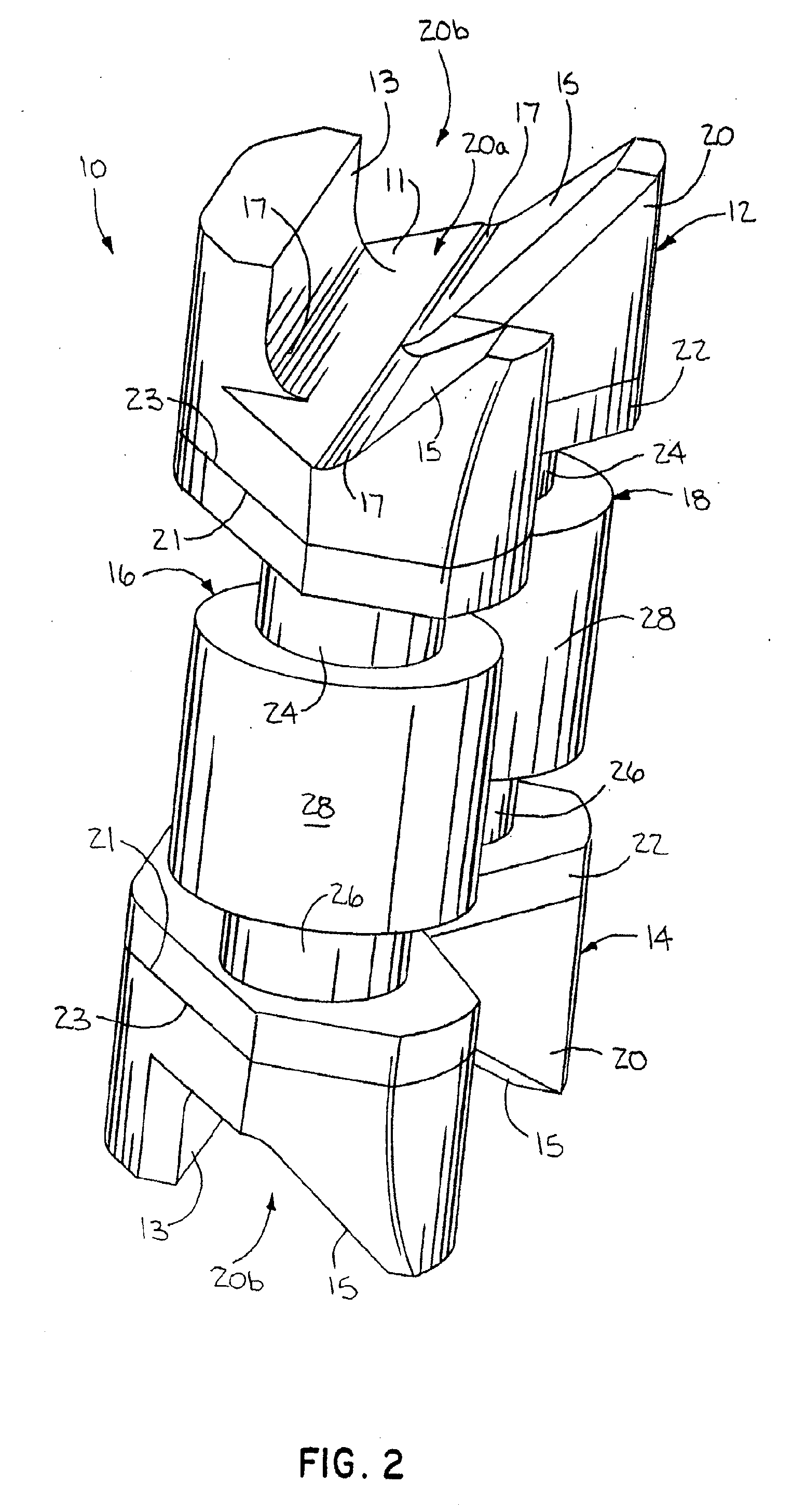Interlaminar Stabilizing System
- Summary
- Abstract
- Description
- Claims
- Application Information
AI Technical Summary
Benefits of technology
Problems solved by technology
Method used
Image
Examples
first embodiment
[0195]Turning to FIGS. 70-73, a twenty-first embodiment of the spinal stabilization system is illustrated in the form of an assembly 2102 of at least two spacer members 2104 joined by a connector 2106. Preferably, the connector is a resilient member that permits some movement between the individual spacer members 2104 as the connector 2106 resiliently flexes. By one approach, each of the spacer members 2104 is generally similar to the previous described spacer members 2004; therefore, only the differences therefrom will be described further.
[0196]As best illustrated in FIGS. 72-73, the assembly 2102 includes the two spacer members 2104a and 2104b joined by the connector 2106 in the form of a thin, resilient connecting strip (such as a titanium or other biocompatible material) that is secured to and extends between the two spacer members 2014a and 2104b. A pair of fasteners 2108 are provided to secure the connector 2106 to each spacer member 2104a and 2104b so that the spacer members...
second embodiment
[0200]Referring to FIGS. 74-81, a twenty-second embodiment of a spinal stabilization system 2202 is illustrated in the form of a unitary laminar spacer 2204 having a configuration that permits it to be inserted from a lateral approach and then pivoted into position where it is wedged between the laminar regions 11 of adjacent vertebrae as shown in FIGS. 75-77. The laminar spacer 2204 may be formed from any resilient-type material, such as polyurethane and the like, or from a more rigid material, such as PEEK or the like. While the spacer 2204 is illustrated as a generally solid member, if formed from a more resilient material, it can optionally include an actuator or adjustment device to shift the spacer 2204 from a compressed to an expanded or distracted configuration similar to that found on the embodiments shown in FIG. 47 (spacer member 1504) or FIG. 58 (spacer member 1804).
[0201]As best shown in FIGS. 77-79, the laminar spacer 2204 has a configuration that provides for the pref...
third embodiment
[0204]Referring to FIGS. 82 to 84, a twenty-third embodiment of a laminar stabilization assembly 2302 is illustrated in the form of a laminar spacer 2304 having an articulating connection 2306 between a superior laminar spacer 2304a and an inferior laminar spacer 2304b. In one form, the articulating connection 2306 includes a cooperating ball and socket joint. As best shown in FIG. 84, the assembly 2302 includes multiple components. For instance, it preferably includes the superior laminar spacer or a superior laminar bra 2304a, a socket portion 2308 joined to the superior laminar spacer 2304a, the inferior laminar spacer or an inferior laminar bra 2304b, a dome or ball portion 2310 joined to the inferior laminar spacer 2304b, a spherical washer 2312, an inside washer 2314, an outside washer 2316, and an fastener 2318 to secure the assembly together.
[0205]Similar to the previously described embodiments, the superior laminar spacer 2304a and the inferior laminar spacer 2304b have sem...
PUM
 Login to View More
Login to View More Abstract
Description
Claims
Application Information
 Login to View More
Login to View More - R&D
- Intellectual Property
- Life Sciences
- Materials
- Tech Scout
- Unparalleled Data Quality
- Higher Quality Content
- 60% Fewer Hallucinations
Browse by: Latest US Patents, China's latest patents, Technical Efficacy Thesaurus, Application Domain, Technology Topic, Popular Technical Reports.
© 2025 PatSnap. All rights reserved.Legal|Privacy policy|Modern Slavery Act Transparency Statement|Sitemap|About US| Contact US: help@patsnap.com



